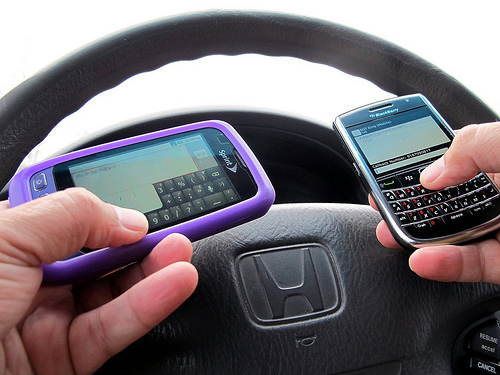
Image from frankieleon.
By now, we’ve all heard the lectures: Don’t text and drive. Hang up and drive. Distracted driving causes crashes. According to a new study, we’re still not listening.
Researchers at the University of the West of England in Bristol assert that the role of mobile phones in crashes is underreported by an alarming percentage. In other words, we know mobile phone use leads to crashes, but we may have no idea just how often that happens.
The report, recently published in the Journal of Transport and Health should be a wake-up call, but it shouldn’t come as a surprise. After all, mobile phones are all-consuming as a distraction. They require “visual, physical, and cognitive attention of the driver.”
Think you’re safe because you’re in California or another area requiring the use of hands-free devices? Think again. Evidence shows that regulations requiring hands-free device use aren’t sufficient to combat the problem. Both hands-free and hands-on use of mobile phones while driving increases the likelihood of a crash fourfold. And that’s just for general mobile phone use, including talking on the phone, which is often (wrongly) considered to be fairly benign behavior compared to texting or surfing the web. Texting while driving increases the likelihood of a crash sixfold.
These terrifying figures are based on epidemiological studies, but we still don’t have the full picture. That’s because actual figures are very difficult to come by. For one thing, statistics from many countries rely solely on police reports to determine the cause of road traffic crashes. Mobile phone usage is often difficult to detect, especially during an initial police report. In the United States, there is no standardized reporting format across all the states, and while police officers are legally required to collect information on the role of mobile phones in road traffic crashes, that information isn’t always readily available. The result: under-reporting of the phone factor.
While some countries, including the United States, are pushing for more complete data via “surveys and in-video footage of vehicles,” these methods “often utilize self-reported data from drivers and hence rely on driver sincerity.” Few people are likely inclined to admit that they ran a stop sign because of a Tweet.
The researchers describe under-reporting of the phone factor as a “world-wide phenomenon” that “should be addressed by a global strategy to improve data collection.” One proposed solution: authorizing police investigators to seize mobile phones at the scene of a crash in order to determine whether or not the phone was in use at the time of the crash. In-vehicle cameras could also help with investigations as well as deter risky behavior in the first place, though there is a clear cost barrier here since drivers would have to purchase the cameras and, barring a legal imperative, be willing to voluntarily use them. Finally, reporting strategies need to be streamlined and standardized to facilitate easy data collection and review.
Of course, the easiest solution is for people to simply own their role in the danger and stop using their phones while driving. But if that worked, this study wouldn’t have been necessary. Driverless cars, anyone?